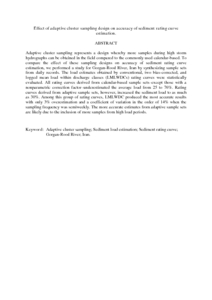Citation
Arabkhedri, Mahmood and Lai, Food See and Ibrahim, Noor Akma and Mohamad Kasim, Mohamad Roslan
(2010)
Effect of adaptive cluster sampling design on accuracy of sediment rating curve estimation.
Journal of Hydrologic Engineering, 15 (2).
pp. 142-151.
ISSN 1084-0699; ESSN: 1943-5584
Abstract
Adaptive cluster sampling represents a design whereby more samples during high storm hydrographs can be obtained in the field compared to the commonly used calendar-based. To compare the effect of these sampling designs on accuracy of sediment rating curve estimation, we performed a study for Gorgan-Rood River, Iran by synthesizing sample sets from daily records. The load estimates obtained by conventional, two bias-corrected, and logged mean load within discharge classes (LMLWDCs) rating curves were statistically evaluated. All rating curves derived from calendar-based sample sets–except those with a nonparametric correction factor–underestimated the average load from 25 to 76%. Rating curves derived from adaptive sample sets, however, increased the sediment load to as much as 30%. Among this group of rating curves, LMLWDC produced the most accurate results with only 3% overestimation and a coefficient of variation in the order of 14% when the sampling frequency was semiweekly. The more accurate estimates from adaptive sample sets are likely due to the inclusion of more samples from high load periods.
Download File
![[img]](http://psasir.upm.edu.my/14200/1.hassmallThumbnailVersion/Effect%20of%20adaptive%20cluster%20sampling%20design%20on%20accuracy%20of%20sediment%20rating%20curve%20estimation.pdf)  Preview |
|
PDF (Abstract)
Effect of adaptive cluster sampling design on accuracy of sediment rating curve estimation.pdf
Download (184kB)
| Preview
|
|
Additional Metadata
Actions (login required)
 |
View Item |

